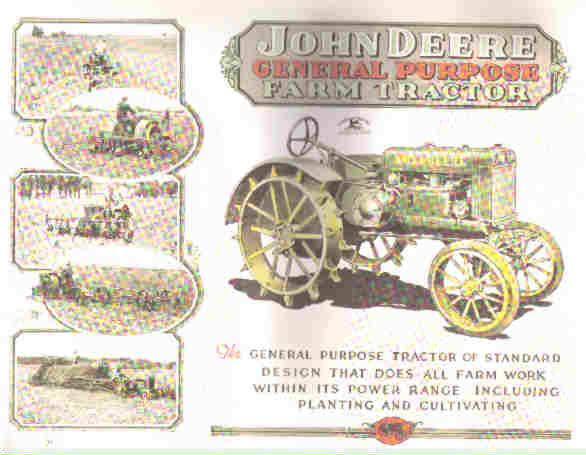GP stood for General
Purpose - a more
versatile Deere Tractor
|
|
GP 1928 to 1935 -
GP wide tread from 1929 to 1933
The John Deere Model GP was not a replacement for the Model D,
but was introduced to farmers as a tractor with increased versatility.
The GP had an exclusive feature....a mechanical lift operated by a foot
pedal. The mechanical lift was a John Deere first and quickly became
copied by other tractor manufacturers.
Adding to the versatility of the Model GP, for use with the tractor....
Deere introduced a 3 row planter, 3 row cultivator, sweep rake, and
7 foot sickle bar mower.
Early 1928 the board at Deere & Company authorized $3.9 million
for construction of more manufacturing facilities at the Waterloo works.
Deere was in the tractor business to stay.
In 1928 the John Deere GP was introduced with an arched front axle
for high clearance of crops, a PTO and belt pulley. The GP started
on gasoline and ran on kerosene.
The original GP had a bore and stroke of 5.75 by 6 inches, and running
at 900 rpm was rated at 10 horsepower at the drawbar and almost
20 at the belt.
Modifications to the Model GP raised these ratings to 15.5 and 24.3
as tested at Nebraska in 1931.
In 1930 the bore was increased to 6 inches. The water injection system
was also dropped as many farmers reported plugging. (At that time,
water injection into the combustion chambers was a wide spread method
of reducing pre-detonation and enhancing the performance of the engines.)
In 1932 a new improved GP Wide Tread was brought out with a tapered
hood that gave the operator better visibility, better steering,
and the first John Deere tractor seat mounted on adjustable cushion
springs. Other improvements were individual rear brakes and the
spark and throttle levers mounted on the steering wheel support
so the operator could change speeds without changing his position.
Serial numbers 200001 to 200110 were experimental with most being
recalled and rebuilt into the Model C. From 1928 to 1930 serial
numbers 200264 to 223802 were Standard Tread GP's, interspersed
among these were 72 Model GP tricycles.
The first John Deere Orchard tractors were a variation on the GP.
The GP Orchard tractors had deep skirt fenders covering the rear wheels
to below the hubs which prevented limbs from catching on the spokes.
The fenders also covered the belt pulley and flywheel.
There was also a GP Wide Tread XO. (Or XOGP) The first model rolled
off the assembly line April 18, 1930, serial number 402040. The XO
models had a "crossover" manifold. Production ended in
October of 1930.
Six of these were rebuilt into the first GPO's. a few others became
experimental CX tractors, 123 were rebuilt becoming what is called the
1931 specifications, and about a dozen serial numbers at the end of
the run were never used.
There were 68 GP standard crossovers built.
1929 John Deere GP advertisement

John Deere Model GP production figures
| Year |
GP |
GP Tricycle |
GP Wide Tread |
GPO |
| 1928 |
1112 |
14 |
|
|
| 1929 |
11,635 |
58 |
676 |
|
| 1930 |
10,676 |
|
1739 |
6 |
| 1931 |
4816 |
|
2213 |
220 |
| 1932 |
384 |
|
328 |
160 |
| 1933 |
167 |
|
147 |
26 |
| 1934 |
1252 |
|
|
176 |
| 1935 |
232 |
|
|
129 |
1930 John Deere GP wide tread
a beautiful restoration by owners, Chris & David Cobler

In 1928 Massey Harris Company took over J.I. Case Plow Works, both
of Racine, Wisconsin. By agreement, between Massey and Case,
the J.I. Case Threshing Machine Company retained the right to
use Case and J.I. Case on their equipment.
The J.I. Case Threshing Machine Company bought the farm implement
business of the Emerson Bratingham Corp. of Rockford Illinois.
By 1932 several companies began experimenting with rubber tires on
their tractors. Previous attempts had been tried born out of the
complaints from Orange grove owners who complained the steel lugs
damaged roots.
In 1931 B.F. Goodrich had on the market their zero pressure tire for
tractors. It was a rubber arch built on a perforated steel base for
attachment to standard steel tire drive wheels.
24 GP tractors were sold to be turned into GPO Lindeman crawlers. They
were called Lindeman John Deere tractors.
Next: John Deere P
Back to John Deere C
A History of John
Deere Tractors
|